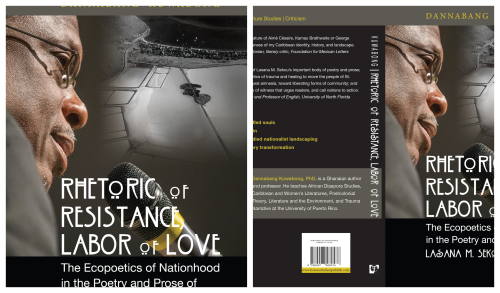 PHILIPSBURG:---Dr. Dannabang Kuwabong’s new book, examining the work of St. Martin writer Lasana M. Sekou, was launched and presented at international conferences in St. Martin and in Prague, Czechia, this summer.
PHILIPSBURG:---Dr. Dannabang Kuwabong’s new book, examining the work of St. Martin writer Lasana M. Sekou, was launched and presented at international conferences in St. Martin and in Prague, Czechia, this summer.
Titled Rhetoric of Resistance, Labor of Love: The Ecopoetics of Nationhood in the Poetry and Prose of Lasana M. Sekou, the publication is now set as required reading for the Caribbean Theory graduate course at the University of Puerto Rico (UPR) this fall, said Kuwabong.
Published by House of Nehesi Publishers (HNP), the book is possibly the first to critically analyze original writings of how St. Martin people were treated as immigrants in countries and territories in the Caribbean and beyond, from the late 1800s to the late 1950s, said HNP president Jacqueline Sample.
“In this groundbreaking study, Dannabang Kuwabong arouses our critical curiosity, our political consciousness, and our aesthetic sensibility,” said Mark Andrews of Vassar College. “He offers a wide-ranging exploration of the multi-layered and richly imaginative creative works of St. Martin’s leading poet, Lasana M. Sekou.”
The book’s five chapters offer an in-depth analysis of Sekou’s poetry, fiction, and essays, including Brotherhood of the Spurs, Love Songs Make You Cry, National Symbols of St. Martin, Mothernation, and The Salt Reaper with its mythopoem about the Great Salt Pond.
While “the debilitating psychosocial cognitive effects of poverty and immigration” on St. Martiners is a key theme in Chapter 1, it represents only a fraction of the issues explored in Rhetoric of Resistance, Labor of Love.
Topics like tourism, agriculture, environmental degradation, cultural amnesia, political betrayal, resilience, succession land as a core cultural value, Dutch and French dependency, the fear of and seminal call for independence, and the now challenged historical unity of the island’s people are discussed not lightly or as dogma, but through sociocultural and historical interpretation. These themes are also explored with careful attention to literary quality.
In the book’s “Fanonian Introduction to Lasana M. Sekou,” Kuwabong describes Sekou’s outlook as “revolutionary”—echoing the no-nonsense Trinidadian critic Gordon Rohlehr, who elsewhere called Sekou the “poet and militant publisher from St. Maarten” (2022).
Kuwabong highlights Sekou’s apparent “decision to write to, from, for, and with his people, and not pander to the international gendarmes of literature who play a role in determining the authors from the Caribbean who are academically elevated.”
Another contentious point, Kuwabong writes, is that Sekou’s “liberationist poetics … may not resonate with the pundits of post-colonial literary studies, as Sekou’s combative and counter-discursive poetics are supposedly counter-progressive and out of sync with their contemporary realities.”
Recognizing that Sekou either doesn’t care about what external policing does, says, or feels—or simply refuses to sugarcoat St. Martin’s colonial and divided-island realities—Kuwabong dives headlong into comparisons between Sekou’s work and the profound nationalist themes found in the writings of Frantz Fanon and Edward Said, as well as Patrick Chamoiseau’s complex framing of Caribbean identity.
The St. Martin writer’s pan-Caribbean, pan-African, and internationalist poetry, uncompromising in its critique of class, race, and national, regional, or global structures of oppression, also comes under Kuwabong’s sharp literary lens, particularly in his analysis of Sekou’s works such as Nativity, Maroon Lives, and Book of the Dead.
The final chapter presents the writer as “a witness to national consciousness,” and it is as much about Sekou as it is a signal—a dialogue—with current and future writers and artists from St. Martin and the wider Caribbean.
Kuwabong, who is originally from Ghana, also references earlier “critical appraisals” of Sekou’s work by Fabian Adekunle Badejo (St. Martin), Howard Fergus (Montserrat/UWI), Emilio Jorge Rodríguez (Cuba), and Sara Florian (Italy).
“What’s truly new is how Dr. Kuwabong draws on trauma scholars to rigorously explore, maybe for the first time in relation to Lasana’s work, the Gothic themes and family traumas tied to individual redemption and community healing of St. Martiners, which Lasana writes about in original and sometimes frightening ways,” said Sample.
Kuwabong’s Rhetoric of Resistance, Labor of Love is, overall, “a most timely, insightful appraisal of Lasana M. Sekou’s important body of poetry and prose: a critical assessment of his ecopoetics of trauma and healing to move the people of St. Martin beyond a historical and cultural amnesia, toward liberating forms of community,” said Keith Cartwright, Chair and Professor of English at the University of North Florida. “And beyond St. Martin, charting a mode of witness that urges readers, and calls nations to action.”
“This book triggered the very same feeling I had when I read for the first time the literature of Aimé Césaire, Kamau Brathwaite or George Lamming: revelation and consciousness of Caribbean identity, history, and landscape,” said David Anuar, award-winning writer, historian, and literary critic at the Foundation for Mexican Letters.
Kuwabong is being warmly welcomed by colleagues as he returns with the new scholarly publication for the fall semester at UPR, where he is teaching literary criticism, Gothic and trauma literature, Caribbean studies, and women’s studies.
“We’re delighted to congratulate Prof. Dannabang Kuwabong for the publication of his new book Rhetoric of Resistance, Labor of Love: The Ecopoetics of Nationhood in the Poetry and Prose of Lasana M. Sekou,” said Sargasso, the peer-reviewed journal of literature, language, and culture edited at UPR.
Rhetoric of Resistance, Labor of Love is available at Arnia’s Bookstore in St. Martin, from the author in Puerto Rico, and online at libroslatinos.com, said Sample.










